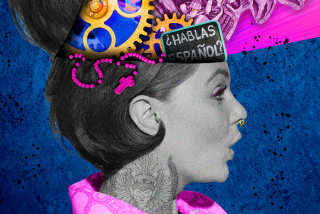The Birth of the Hispano-Indian Civilizations of the New World : Quincentennial: The values of our continuous culture have not been translated to the hemisphere’s fragmented politics and failed economics.
- Share via
The year 1492 expanded and unified the planet. The navigational feat of Christopher Columbus is unparalleled. He put his wager on a scientific hypothesis and won: Since the Earth is round, you can reach the East by sailing west.
But Columbus was wrong in his geography. He thought that he had arrived in the fabled lands of Cipango (Japan) and Cathay (China). Finding a domain empty of the Asian treasures he had hoped for, he invented and reported back to Spain the discovery of great wealth in forests, pearls and gold. Otherwise, his patroness, Queen Isabel, might have thought her investment (and her faith) in the highly inventive Genoese sailor had been misplaced. In effect, Columbus was the founder of that subgenre of literature called Latin American Magical Realism.
Numbers can deceive, but evidence tells us that the people whom Columbus found in the Caribbean had totally disappeared 50 years later. Two historians of the colonial experience in Latin America, Barbara and Stanley Stein, estimate the population of central Mexico at 25 million when the conquest began in 1519. In 1605, the population was 2 million. In the central Andes, a population of 6 million in 1525 had sunk to 1.5 million in 1561.
The reasons for this demographic catastrophe were complex, cumulative and brutal: European diseases, immunological breakdowns, forced labor but also culture shock and sheer anguish. But numbers are not the most important fact about the European conquest of America. The violent deaths with which the Europeans--Spanish, Portuguese, English, French, Dutch--implanted their power in the New World is but the statistical index of a far larger occurrence: the irreparable death of great civilizations that possessed education systems, a separate moral and artistic universe, and forms of human relationship in constantly evolving creativity.
But did the conquest truly destroy the Indian cultures forever? In one sense, we must answer yes. We shall never know how the Indian civilizations would have evolved without foreign interference. An interrupted destiny is never a just destiny. But if the fate of pre-Columbian America was to lose its autonomous evolution, it is also true that the very brutality of the conquest manifested the Indian capacity to survive in spite of the most violent challenges.
For the Indian culture of the Americas, if it did not prevail, did not perish, either. Rather, it became a part of what one might term the counterconquest, that is, the Indian response, followed by the black response, to the purely European presence in the Americas. And Spain herself, far from being a “pure” Catholic nation, as the monarchs Ferdinand and Isabel dogmatically desired, was a crossroads country, a land of many migrants, crisscrossed and shaped by Iberians and Celts, Phoenicians, Greeks and Romans, Goths, Arabs and Jews.
The conquest of America continues to be the pause of our historical memory, the origin of our intense self-consciousness and of the painful brotherhood between the death of the Indian civilizations of the Americas and the birth of the Hispano-Indian civilizations of the New World. Eternal witnesses to our own creation, we the descendants of Indians and Spaniards in the Americas know that the conquest was a cruel, criminal, bloody event. It was a catastrophic event. But it was not a sterile event.
From the catastrophe of the conquest, all of us, the Indoiberoamericans, were born. We were, immediately, mestizos--men and women of both Indian and European blood. Spanish America did not suffer the sexual hostility of Anglo America. The vast majority of us speak Spanish. And whether we believe, we created ourselves inside the culture of Catholicism--but of a Catholicism bathed in syncretism and unexplainable without its Indian and, later, black African masks.
On these realities, we built a new civilization, whose hubs were our great cities, a necklace of true Indoafroeuropean cities of the Spanish-speaking Americas, from Los Angeles to Buenos Aires, from Havana to Lima. No one, ever, built so much, with as much energy, in so short a time and over so much space, as Spanish America. Cities with printing presses, universities, painters and pests, a century before any of this came into being in Anglo America. Indian, black, mestizo and mulatto forever left their imprint on the churches, the civil architecture, the arts and crafts of our continent.
But also cities built on injustice. And it is in response to the questions of justice that Spain played a most singular role in the history of the colonizations of the New World. Spain, the most extensive empire the world had known, was the only empire of its time, and the first in history, to debate with itself on the nature and mistakes of its colonial policies.
Only Spain did it, not the other colonial powers, whose crimes of enslavement and extermination were compatible to those of Spain, but without the doubt, the debate, the discourse that permitted Spain to enshrine and defend, as much as possible yet never enough, the rights of the Indian peoples of the Americas.
Out of this debate of Spain with herself, three facts emerged. First, from this debate was born the modern concept of international law, based on the universality of human rights, which the great Spanish intellectual of the 16th Century, Francisco Suarez, explained by placing the origin of all authority in the people. For this reason, he said, no people can be legitimately subjected to conquest by others. This is as valid today.
Insufficient as it was, Spain’s protection of the vast agrarian hinterland of Indoiberiamerica was far greater than that accorded the Indians by the independent republican governments after 1821. The newly minted Spanish American republics identified economic liberalism with progress and agrarian culture, including Indian culture, with barbarism. This rationalization permitted our republican governments to strip the agrarian communities of their aboriginal and even colonial rights. This was the reason for the modern agrarian insurrections that, like Emiliano Zapata’s in Mexico, did nothing but reclaim rights granted the rural townships by the Spanish crown.
The third fact is that, in 1992, the conquest is not over and we, the modern Latin Americans, have behaved with as much cruelty or indifference toward the Indians as Columbus or Pizarro, and certainly with less compassion than Bartolome de Las Casas or Francisco de Vitoria. In this, as in most matters, our reflection about 1992 should address itself to the future rather than to the past.
We must decide whether we are able to respect the values of Indian culture: the sense of the community and of the sacred, the care of nature, the concern for memory and death, the atavistic wisdom, the ritual intensity, the presence of mystery and the capacity of self-government, thus making them, as far as we can, our own; thus admitting the value of the other who lives in our midst.
Finally, 1992 permits us in Latin America to clearly understand that during the past 500 years we have created a continuous, fluid, strong and vibrant culture--Indian, black, European, above all, mestizo. Let us not celebrate the quincentennial too much. But let us not deplore too much, either. Let us not see our past only as a protracted crime, or only as a civilizing epic: only as feat or only as defeat. We are what we are because we made the culture that unites us. But we have failed in translating the values of our continuous culture to the fragmented politics and the failed economics of our hemisphere.
Can we hope, as a new century and a new millennium begins, to animate the plurality of our cultures so that they reflect their values in our political and economic institutions, giving them vigor, substance and a greater sense of justice? Indeed we can, if only we realize that we have a good culture because we made it ourselves, and a bad politics and economics because, perhaps, they were made for us. The next 500 years begin today. Their protagonist must no longer be the centralized institutions of the past--church, army, state--but the emerging civil societies of Latin America. They are, after all, both the creators and the bearers of the culture.
More to Read
Sign up for Essential California
The most important California stories and recommendations in your inbox every morning.
You may occasionally receive promotional content from the Los Angeles Times.













